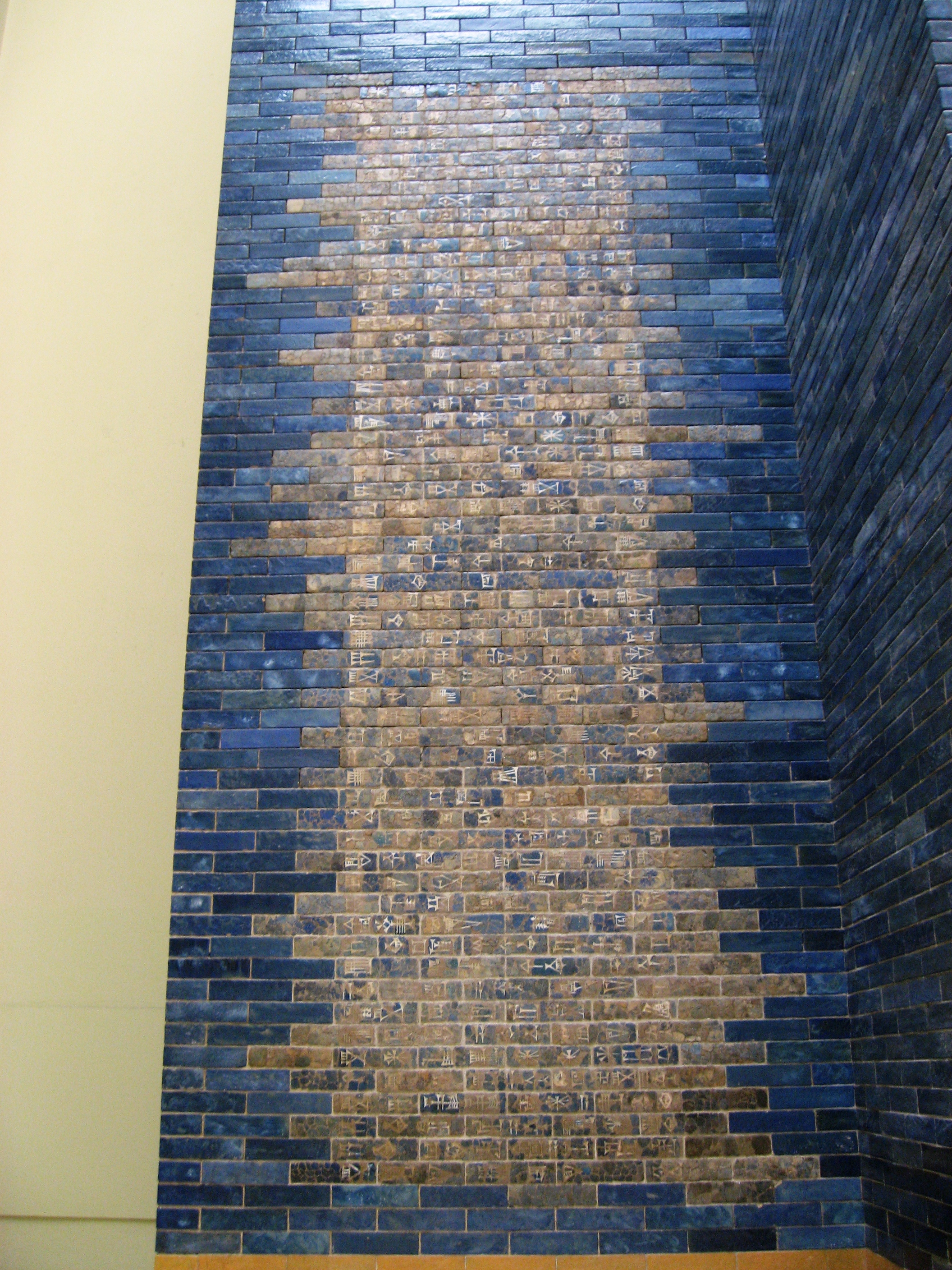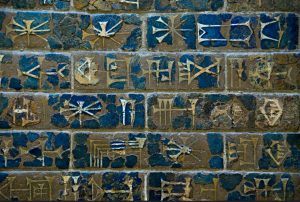This is an addendum to: Copenhagen Glyptotek shows three glazed brick reliefs from Ishtar Gate. 1. young bull, 2. lion and 3. animal, like a composite animal of Indus Script
https://tinyurl.com/y2sp5god
https://tinyurl.com/y2sp5god
Three animals are prominently decorated on the Ishtar Gate and procession passageway: one-horned young bull, lion and a composite animal, mušḫuššu. All three are metalwork catalogues.
In Mesopotamian narratives, the association of the three hieroglyphs are with Marduk, Ishtar and Adad 'storm and rain divinity'. The memories of the metalwork of the Meluhha assur, ancestors result in the veneration of these divinities in the Ishtar temple and Ziggurat. It is notable that the stupa of Mohenjo-daro is also a ziggurat celebrated in Sit Shamshi Bronze as the veneration of the Sun divinity with water ablutions.
Veneration of Marduk is cognate with the veneration of Marut in R̥gveda. मरुत् gold(नैघण्टुक , commented on by यास्क i, 2);m. pl. (prob. the " flashing or shining ones " ; cf. मरीचि) the storm-gods (इन्द्र's companions and sometimes e.g. Ragh. xii , 101 = देवाः , the gods or deities in general ; said in the वेद to be the sons of रुद्र and पृश्नि q.v. , or the children of heaven or of ocean ; and described as armed with golden weapons i.e. lightnings and thunderbolts , as having iron teeth and roaring like lions , as residing in the north , as riding in golden cars drawn by ruddy horses sometimes called पृषतीः q.v. ; they are reckoned in Naigh. v , 5 among the gods of the middle sphere , and in RV. viii , 96 , 8 are held to be three times sixty in number ; in the later literature they are the children of दिति , either seven or seven times seven in number , and are sometimes said to be led by मातरिश्वन्) RV.
The ribbon of flowers below the young bull: करडई karaḍī f Safflower, Carthamus. 2 Its seed. करडी karaḍī f (See करडई) Safflower: also its seed. करडेल karaḍēla n (करडई& तेल) Oil of Carthamus or safflower. karaṭa*kara ṭataila ʻ oil of safflower ʼ. [kara ṭa -- 2 , tailá -- ] M. karḍel n. ʻ oil from the seed of safflower ʼ.(CDIAL 2788, 2789) Rebus: करडा [ karaḍā ] Hard fromalloy--iron, silver &c. Rebus 2: kharādī = turner (G.) Rebus 3: kharaḍa, brief memoranda of metalwork Rebus: karaṇḍi 'fire-god' (Remo)Remo <karandi>E155 {N} ``^fire-^god''.(Munda).
kōḍu 'horn' rebus koḍ 'workplace'
The Ny Carlsberg Glyptotek (NCG) in Copenhagen is in possession of three glazed brick reliefs from the Babylonian entrance complex (Fig. 1-3) acquired by the Museum in 1930 from the Vorderasiatisches Museum, Berlin. We can identiy the young bull and the lion.What is the third animal?
Sign Buccarella et al, 2016, Babylonian Blues: Studying the blue and turquoise-green glazes of the Ishtar Gate and the Processional Way
[quote]Despite earlier studies of glazed bricks from Babylonia, the nature of especially the blue and turquoise pigments is still debated. The only published investigations into the colored glazes of the monumental gate complex were carried out in the 1980’s by Fitz and Matson . However, neither of the two studies includes bricks from the Ishtar Gate. Moreover, they are not conclusive concerning the identification of the pigments used for the blue and turquoise-green glazes.
The three reliefs in the NCG offer a rare opportunity to investigate the pigments used for the monumental structure. In this preliminary study, the blue and turquoise-green glazes on the reliefs have been examined using X-Ray Fluorescence spectroscopy (XRF), polarised light microscopy, and Laser Ablation Inductively Coupled Mass Spectrometry (LA-ICP-MS).
Besides settling the discussion concerning the nature of the pigments, the identification of the constituents of the glazes will offer important insights into the trade of materials and crafts involved in the embellishment. [unquote]
1. Young bull:
'Unicorn' is खोंड khōṇḍa 'young bull, bullcalf' rebus کار کند kār-kund 'manager' (Pashto) कारकून 'scribe' (Marathi) kundaṇa find gold (Tulu)
2. Lion: arya 'lion' (Akkadian) rebus: āra 'brass'.
?3. Composite animal of Indus Script?

bas-relief in the Pergamon Museum. (𒈲 MUŠ is the Sumerian term for "serpent". Rebus मूष 'crucible'.
mušḫuššu (𒈲𒄭𒄊; formerly also read as sirrušu, sirrush) is a creature from ancient Mesopotamian mythology. A mythological hybrid, it is a scaly dragon with hind legs resembling torso of a fish, the talons of an eagle with wings, feline fore paws, a long neck and tail of a snake, a horned head, a snake-like tongue, and a crest. The mušḫuššu most famously appears on the reconstructed Ishtar Gate of the city of Babylon, dating to the sixth century BCE.
The form mušḫuššu is the Akkadian nominative of the Sumerian𒈲𒄭𒄊 MUŠ.ḪUS, "reddish snake". https://en.wikipedia.org/wiki/Mušḫuššu
I submit that the representation is NOT that of a real animal nor is it a mythologized real animal, but an Indus Script hypertext, comparable to many types of composite animals which constitute Indus Script Corpora. The composite animals are read rebus as hypertexts composed of a variety of animals and hieroglyphs to signify a metalwork catalogue.
Thus, the components of the composite animal mušḫuššu is read rebus in Meluhha:
phaḍā 'serpent hood' rebus: phaḍā 'metals manufactory public officers'
nāga'serpent' rebus: anakku 'tin' नाग 'tin, lead'(भावप्रकाश)
śyena 'falcon' aśáni 'thunderbolt' rebusآهن ګر āhan gar, '
panja 'feline paws' rebus; panja 'kiln, smelter'
Ka. eṟake, eṟaṅke, ṟakke, ṟekke wing; ṟaṭṭe, ṟeṭṭe wing, upper arm.Ta. ciṟai, ciṟaku, ciṟakar wing; iṟai, iṟaku, iṟakar, iṟakkai wing, feather. Ma. iṟaku, ciṟaku wing. Ko. rek wing, feather. Koḍ. rekke wing; raṭṭe upper arm. Tu. ediṅke, reṅkè wing. Te. eṟaka, ṟekka, rekka, neṟaka, neṟi id. Kol. reḍapa, (SR.) reppā id.; (P.) reṛapa id., feather. Nk. rekka, reppa wing. Pa. (S.) rekka id. Go. (S.) rekka wing-feather; reka (M.) feather, (Ko.) wing (Voc.3045). Konḍa ṟeka wing, upper arm. Kuwi (Su.) rekka wing.(DEDR 2591) eraka 'moltencast
Hieroglyph: crest, crown: Pa. makuṭa -- m. ʻ crest ʼ; Pk. maüḍa -- , maüla -- m.n. ʻ diadem; ʼH. mauṛ, mauṛā m., maulī, maulṛī f. ʻ crown ʼ; OG. maüḍa m. ʻ crown ʼ(CDIAL 10144) Ta. mukaṭu top, highest part, ridge of a roof, hump of a camel, platform; mōṭu height, hill, eminence, top of a house, etc.;mucci crown of the head, tuft of hair on the head, crest. Ma. mukaṭu the head-end of a cloth; mukaḷ top, summit, ridge, roof. Ko.moyḷ ridge of roof. To. muxuḷ id. Ka. mogaḍu, mogaḷu, magil id. Tu. mugili turret, top as of a temple; mōḍu hill. Te. mogaḍuridge of roof; mōḍu raised or high ground; (Inscr.) mōru peak. Go. (W. Ph.) mukur comb of cock (Voc. 2864). / Cf. Skt.mukuṭa-, mauli- crest, diadem; BHS, Pali makuṭa- id.; Pkt. maüla- id.; Turner, CDIAL, no. 10144.(DEDR 4888) Rebus: muhã 'quantity of metal produced out of smelter' (Santali)
kōḍu'horn' rebus koḍ'workplace'
beḍa hako (ayo) ‘fish’ (Santali); beḍa ‘either of the sides of a hearth’ (G.) Munda: So. ayo `fish'. Go. ayu `fish'. Go <ayu> (Z), <ayu?u> (Z),, <ayu?> (A) {N} ``^fish''. Kh. kaDOG `fish'. Sa. Hako `fish'. Mu. hai (H) ~ haku(N) ~ haikO(M) `fish'. Ho haku `fish'. Bj. hai `fish'. Bh.haku `fish'. KW haiku ~ hakO |Analyzed hai-kO, ha-kO (RDM). Ku. Kaku`fish'.@(V064,M106) Mu. ha-i, haku `fish' (HJP). @(V341) ayu>(Z), <ayu?u> (Z) <ayu?>(A) {N} ``^fish''. #1370. <yO>\\<AyO>(L) {N} ``^fish''. #3612. <kukkulEyO>,,<kukkuli-yO>(LMD) {N} ``prawn''. !Serango dialect. #32612. <sArjAjyO>,,<sArjAj>(D) {N} ``prawn''. #32622. <magur-yO>(ZL) {N} ``a kind of ^fish''. *Or.<>. #32632. <ur+GOl-Da-yO>(LL) {N} ``a kind of ^fish''. #32642.<bal.bal-yO>(DL) {N} ``smoked fish''. #15163. Rebus: aya 'iron' ayas 'alloy metal' अयस् n. iron , metal RV. &c; an iron weapon (as an axe , &c ) RV. vi , 3 ,5 and 47 , 10; gold (नैघण्टुक , commented on by यास्क); steel L. ; ([cf. Lat. aes , aer-is for as-is ; Goth. ais , Thema aisa ; Old Germ. e7r , iron ; Goth.eisarn ; Mod. Germ. Eisen.]).
Nebuchadnezzar's Inscription plaque

The cuneiform inscription of the Ishtar Gate in the Pergamon Museum in Berlin
Inscription:
Source: Marzahn, Joachim (1981). Babylon und das Neujahrsfest. Berlin: Berlin : Vorderasiatisches Museum. pp. 29–30. 
Keilschrift im Detail I (A.Schauervilla) by A.Schauervilla (flickr)Tags: berlin museum germany deutschland alemania schriftallemagne pergamonmuseum germania pergamon keilschrift
 Detail of the plaque.
Detail of the plaque.Deutsch: Bauinschrift des Königs Nebukadnezar II. 604-562 v. Chr.
English: Building Inscription of King Nebukadnezar II, 604-562 BC. During the excavations of Babylon, in the immediate vicinity of the Ishtar Gate, numerous fragments of bricks with remains of white-glazed cuneiform characters have been found. These fragments obviously belonged to a building inscription of Nebuchadnezzar II at the gate. Their exact location is unknown but there is no doubt that the text refers to the construction of the gate. The text was restored by comparison to with another complete inscription on a lime stone block and gives three excerpts of this main inscription of the king. Abridged excerpt: "I (Nebuchadnezzar) laid the foundation of the gates down to the ground water level and had them built out of pure blue stone. Upon the walls in the inner room of the gate are bulls and dragons and thus I magnificently adorned them with luxurious splendour for all mankind to behold in awe."

[quote]In this photo, part of the so-called the inscription plaque (or building inscription) of the Ishtar Gate appears. The cuneiform inscriptions of the whole text read:
"I (Nebuchadnezzar) laid the foundation of the gates down to the ground water level and had them built out of pure blue stone. Upon the walls in the inner room of the gate are bulls and dragons and thus I magnificently adorned them with luxurious splendour for all mankind to behold in awe."
These glazed bricks were found near the main Ishtar Gate during the German excavations of the area, 1902-1914 CE. Neo-Babylonian period, circa 575 BCE. From Babylon (modern Babel Governorate), Mesopotamia, Iraq. (The Pergamon Museum, Berlin).[unquote]
https://www.ancient.eu/image/2990/nebuchadnezzars-inscription-plaque/

